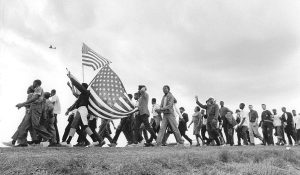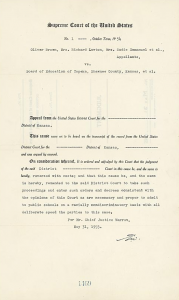Brown vs. Board of Education Decision (1955)
This source is a court document from the District Court of Topeka, Kansas. It was filed on May 31, 1955 and established law that stated:
“Is hereby, remanded to the said District Court to take such proceedings and enter such orders and decrees consistent with the opinions of this Court as are necessary and proper to admit to public schools on a racially nondiscriminatory basis with all deliberate speed the parties to this case.”
The case was argued by the NAACP Chief Counsel Thurgood Marshall. The decision in favor of the case overturned the decision made in the Plessy vs. Fergasun case in 1896 about the idea of “separate but equal.” Marshall argued that separate but equal was in fact not equal. Schools segregated for African American children were inherently worse off than schools for white children. Marshall won the case and it outlawed the segregation of schools in the United States. This was a fantastic victory for the civil rights movement but was not entirely effective. In the decision made by the court, it states that public schools must admit students based on a racially nondiscriminatory basis with all deliberate speed. States took advantage of this soft language and stalled in their integration of schools. Despite its minor shortcoming, the Brown vs. Board of Education case had a profound impact on creating equality in education.
Selma-Montgomery March for Voting Rights (1965)

The image captured here shows a group of activists marching 54 miles from Selma to Montgomery, Alabama. Led by Martin Luther King Jr., the march gained national attention as a peaceful demonstration for voting rights. Throughout history African Americans were constantly disadvantaged from voting whether it be from literacy tests, poll taxes, or intimidation. The 1964 Civil Rights Act made discrimination based on race illegal, but it still persisted in Alabama. In Selma, only 355 of the 15,000 African American residents were permitted to vote. King worked with groups like the Southern Christian Leadership Council and the Students Nonviolent Coordination Committee to gather support for the movement and start the campaign for complete voting rights. Like many other marches, the march from Selma to Montgomery was met with backlash from the state police. The state governor called upon the state police to halt the march even through means of violence. A violent backlash such as this only strengthened the movement and eventually the Voting Rights Act passed in Congress.
LBJ Phone Call to Martin Luther King Jr. (1965)
This audio recording is a phone call between President Lyndon B. Johnson and Martin Luther King Jr. It took place on July 7, 1965 while President Johnson was in the Oval Office and King was in Alabama. During the call President Johnson expresses his support for King’s suffrage movement and describes the steps he is taking in order to get the Voting Rights Act passed through the house and Senate. President Johnson also discusses the difficulty of repealing the poll tax due to differences in political agendas in the house and the Senate. This phone call is one of many that President Johnson had with King during the civil rights movement. It is a great example of the positive relationship of the President and a civil rights leader, but also reveals the political gridlock that made legislative change for equality difficult in the United States.

